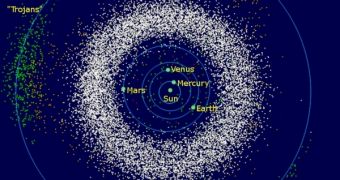The couple of meteorites was found in Antarctica during the 2007/2008 field season and constitutes a premiere for the scientific community – they are the first rocks from the solar system to have andesite on them, the heavy rock that forms the tectonic plates beneath our feet. Thus far, researchers believed that andesite required the enormous forces of tectonics in order for the correct amount of each of its ingredients to come together, but the two new meteorites show that the rock can also form on asteroids.
The two new rocks, dubbed GRA 06128 and GRA 06129, most likely came from a yet-undifferentiated asteroid from our solar system. The age of the parent celestial body is estimated to be at about 4.5 billion years, which is roughly the age of our own planet. Scientists are puzzled as to how andesite came to form on the undifferentiated asteroid in the first place, but geologists think they may have an answer to that question.
According to their theories, the temperature in the core of the “father” asteroid was high enough to partially melt the rocks on the crust, but insufficient to do so completely. Thus, volcanic eruptions most likely threw primitive rocks in space, which later became the meteorites GRA 06128 and GRA 06129, which crash-landed in Antarctica.
"Our work illustrates that the formation of planet-like andesite crust has occurred by processes other than plate tectonics on solar system bodies. Ultimately this may shed light on how evolved crust forms on planets, including Earth, during the earliest stages of their birth," explains James Day, the lead author of the new study, who is also a researcher at the University of Maryland.
"What is most unusual about these rocks is that they have compositions similar to Earth's andesite continental crust – what makes up the ground beneath our feet. No meteorites like this have ever been seen before," he adds.
The large 4 Vesta asteroid is believed to be the origin for the two meteorites, as their oxygen isotope signatures closely match that of other small rock fragments believed to have originated from the same place. Experts say that, most of the time, they don't know what asteroids meteorites come from, but that they can figure out if certain rocks came from the same celestial body or not.

 14 DAY TRIAL //
14 DAY TRIAL //